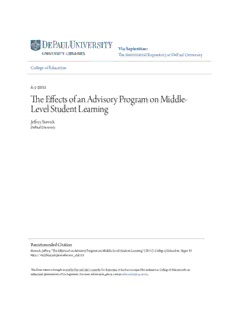
The Effects of an Advisory Program on Middle-Level Student Learning PDF
Preview The Effects of an Advisory Program on Middle-Level Student Learning
DDeePPaauull UUnniivveerrssiittyy DDiiggiittaall CCoommmmoonnss@@DDeePPaauull College of Education Theses and Dissertations College of Education Spring 6-2011 TThhee EEffffeeccttss ooff aann AAddvviissoorryy PPrrooggrraamm oonn MMiiddddllee--LLeevveell SSttuuddeenntt LLeeaarrnniinngg Jeffrey Stawick DePaul University Follow this and additional works at: https://via.library.depaul.edu/soe_etd Part of the Elementary and Middle and Secondary Education Administration Commons, and the Junior High, Intermediate, Middle School Education and Teaching Commons RReeccoommmmeennddeedd CCiittaattiioonn Stawick, Jeffrey, "The Effects of an Advisory Program on Middle-Level Student Learning" (2011). College of Education Theses and Dissertations. 43. https://via.library.depaul.edu/soe_etd/43 This Dissertation is brought to you for free and open access by the College of Education at Digital Commons@DePaul. It has been accepted for inclusion in College of Education Theses and Dissertations by an authorized administrator of Digital Commons@DePaul. For more information, please contact [email protected]. EFFECTS OF AN ADVISORY PROGRAM ON LEARNING 1 The Effects of an Advisory Program on Middle-Level Student Learning Jeffrey A. Stawick DePaul University Submitted in Partial Fulfillment of the Requirements for the Degree of Doctor of Education April 2011 EFFECTS OF AN ADVISORY PROGRAM ON LEARNING 2 We approve the dissertation of Jeff Stawick. ________________________________________ ________________________ Joan Lakebrink, Ph.D. Date Professor of Educational Leadership Chair of Committee ________________________________________ ________________________ Fr. Patrick McDevitt, Ph.D. Date Associate Professor Human Services and Counseling ________________________________________ ________________________ Harold London, Ed.D. Date Visiting Assistant Professor Secondary Education ________________________________________ ________________________ William Hoecker Date Superintendent in Residence Clinical Director Educational Leadership EFFECTS OF AN ADVISORY PROGRAM ON LEARNING 3 Abstract The purpose of this study is to explore if a middle school advisory program significantly affected student learning. Educators who advocate for the middle school concept for middle-level education claim that purposefully designed advisory programs can have specific beneficial effects. However, a limited body of knowledge and little empirical evidence supports this assumption. This study uses an ex post facto quasi-experimental design comparing three consecutive eighth grade classes in a middle school where such an advisory program was developed. The program was designed to improve student learning through improved relationships, interventions, and additional instruction time. The first eighth grade class had no advisory program; the second had one year of advisory during eighth grade; the third group had two years of advisory during seventh and eighth grade. The researcher‘s hypothesis is that learning improved as a result of the program and that increased exposure resulted in increased learning. To substantiate this, the study looks at ANOVA comparing differences in learning measures by year of study. The study also employs ANCOVA to compare years of study within the subgroups (covariates) of race, gender and income. Comparisons were made utilizing student grade point average, Illinois Standards Achievement Test (ISAT) scores, and Northwest Evaluation Association (NWEA) test scores for each class of students. Results indicated no significant differences in learning measures‘ outcomes by year. Several main effects were EFFECTS OF AN ADVISORY PROGRAM ON LEARNING 4 found in the comparison of performance of students by race, income, and gender. Limitations of this study as well as implications for middle-level school practice and recommendations for future research are also included. EFFECTS OF AN ADVISORY PROGRAM ON LEARNING 5 TABLE OF CONTENTS Page ABSTRACT…………………………………………………………..3 LIST OF TABLES…………………………………………………....8 LIST OF FIGURES............................................................................10 CHAPTER 1. INTRODUCTION……………………………………………….11 The Story……………………………………………………..12 The Problem………………………………………………….15 The Rationale………………………………………………...15 The Significance……………………………………………...16 The Purpose…………………………………………………..17 2. LITERATURE REVIEW..............................................................18 Introduction..........................................……………………….18 A Historical Perspective...........................................................20 Middle School Philosophy Overview………………………...22 Middle School Advisory Programs Overview………………..27 Rationale for Advisory Programs.............................................33 Preventing Student Anonymity.................................................36 Curriculum of Advisory Programs...........................................40 Advisory Programs‘ Outcomes.................................................45 Advisory Program Recommendations for Implementation......48 Directions for Future Research.................................................52 Conclusion................................................................................53 EFFECTS OF AN ADVISORY PROGRAM ON LEARNING 6 3. METHODOLOGY.........................................................................55 Background – Problem Statement............................................55 Research Question....................................................................55 Hypotheses................................................................................56 Design.......................................................................................57 Sample......................................................................................59 Measures...................................................................................59 Student GPA...................................................................60 Illinois Standards Achievement Test of Math................62 Northwest Evaluation Association Test of Math............65 Data Collection.........................................................................68 Data Analysis............................................................................69 Limitations................................................................................69 Summary...................................................................................71 4. RESULTS......................................................................................72 Introduction..............................................................................72 Research Questions and Hypotheses………............................73 Population Subgroups...............................................................77 Grade Point Average (GPA).....................................................79 GPA, when considered by subgroup..............................80 Illinois Standards Achievement Test (ISAT) of Math..............87 ISAT, when considered by subgroup.............................90 Northwest Evaluation Association (NWEA) Measures of Academic Progress (MAP) Math Test.................97 NWEA, when considered by subgroup..........................98 EFFECTS OF AN ADVISORY PROGRAM ON LEARNING 7 Additional Exploratory Research...........................................105 5. DISCUSSION..............................................................................108 Introduction.............................................................................108 Summary of Findings.............................................................110 Performance by year of study, within race...................112 Performance by year of study, within income..............112 Performance by year of study, within gender...............113 Discussion...............................................................................113 Recommendations for Further Research................................117 Practical Implications.............................................................119 Conclusions............................................................................120 APPENDIX.......................................................................................121 REFERENCES.................................................................................122 EFFECTS OF AN ADVISORY PROGRAM ON LEARNING 8 LIST OF TABLES Table # Caption Page Table 1 ―Question 1:…‖ 60 Table 2 ―Question 2:…‖ 60 Table 3 ―Question 3:…‖ 61 Table 4 ―Reliability...‖ 64 Table 5 ―Estimating 2006 ISAT Scores...‖ 75 Table 6 ―Original Populations by Race‖ 78 Table 7 ―GPA by Year of Study‖ 79 Table 8 ―GPA by Gender (All Years of Study)‖ 81 Table 9 ―GPA by Race (All Years of Study)‖ 82 Table 10 ―GPA by Income (All Years of Study)‖ 83 Table 11 ―Between-Subjects Factors‖ 84 Table 12 ―Tests of Between-Subjects Effects‖ 85 Table 13 ―ISAT by Year of Study‖ 87 Table 14 ―Multiple Comparisons, ISAT...‖ 88 Table 15 ―ISAT by Gender (All Years of Study)‖ 90 Table 16 ―ISAT by Race (All Years of Study)‖ 91 Table 17 ―ISAT by Income (All Years of Study)‖ 92 Table 18 ―Between-Subjects Factors‖ 93 EFFECTS OF AN ADVISORY PROGRAM ON LEARNING 9 LIST OF TABLES (CONT.) Table Caption Page Table 19 ―Tests of Between-Subjects Effects‖ 94 Table 20 Estimated Marginal Means: 96 Race * School Year of Study Table 21 ―NWEA by Year of Study‖ 97 Table 22 ―NWEA by Gender (All Years of Study)‖ 99 Table 23 ―NWEA by Race (All Years of Study)‖ 100 Table 24 ―NWEA by Income (All Years of Study)‖ 101 Table 25 ―Between-Subjects Factors‖ 102 Table 26 ―Tests of Between-Subjects Effects‖ 103 Table 27 ―Year of Study by Race‖ 106
Description: